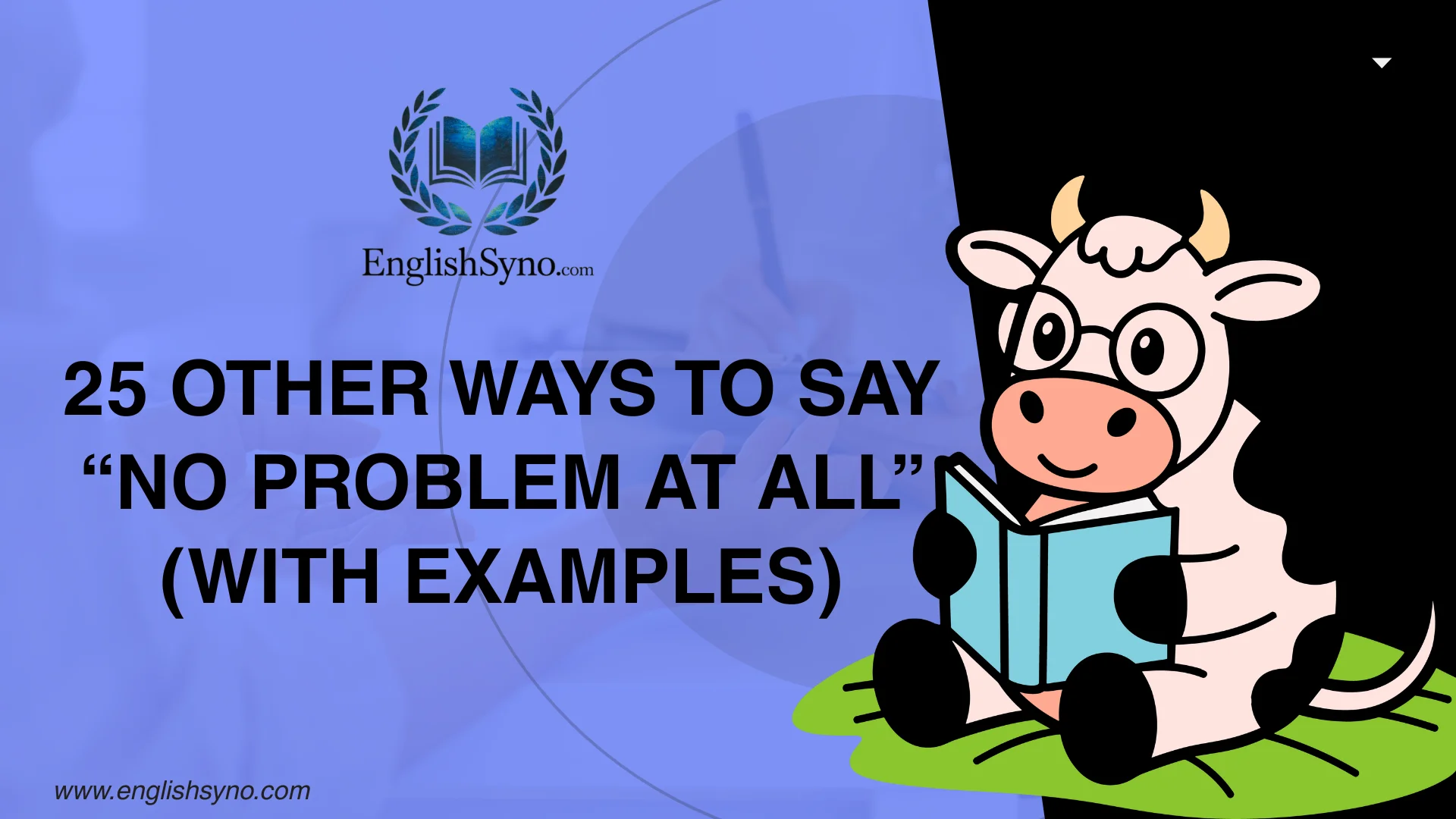When I first realized how natural it felt to say no problem at all, it struck me as more than an emphatic or friendly phrase; it could indicate a situation as acceptable, where I felt genuinely happy to help and never saw the favor as a burden. Over time, this robust version of “no problem” proved less formal but warmer than a simple you’re welcome. Some thought it seemed unprofessional or even lazy, but in generally informal settings, it truly works. I often convey ease by showing something is already done without issue, which helps to reassure people not to worry. When given thanks, I sometimes consider saying “don’t mention it,” or, depending on my relaxed attitude, I’ll try phrases like “no dramas,” “no worries,” or “it’s no trouble” to emphasize a sincere willingness to assist.
These expressions vary in tone and suit different interactions or relationships while keeping me exploring how to express myself and enrich my communication repertoire daily. The main points always show acknowledgment and readiness, whether I want to downplay gratitude casually or respond in ways that feel suitable and close. They often assure effortless solutions, helping in promoting a laid-back atmosphere that naturally conveys ease and reassurance. By maintaining support and letting kindness seem effortless, I’ve found that even small words shape how we communicate in English. With eight alternative expressions I’ve got today, I enjoy incorporating responses in conversations and paying attention to how other speakers are using them, especially when concerns seem unnecessary.
What Does “No Problem at All” Mean?
The phrase “no problem at all” is an emphatic, friendly expression that indicates a request or favor was not a burden. It reassures the other person that their concern is acceptable and that you are happy to help. It is stronger than simply saying “no problem” but less formal than “you’re welcome.” It conveys warmth, kindness, and reassurance in everyday interactions.
When to Use “No Problem at All”
You can use “no problem at all” when someone thanks you, apologizes for an inconvenience, or asks for assistance. It works well in informal settings such as with friends, coworkers, or casual conversations. It’s especially effective when you want to show a relaxed, supportive, and willing attitude.
Is It Professional/Polite to Say “No Problem at All”?
In professional communication, the phrase can sometimes feel too casual. While it is polite, it might not always be the best choice in formal situations, especially with clients or executives. However, with coworkers or in a relaxed workplace culture, it is generally acceptable and warm.
Pros or Cons
Pros:
- Conveys warmth and friendliness.
- Shows willingness and readiness to help.
- Works well in casual or supportive conversations.
Cons:
- It may sound unprofessional in very formal situations.
- Some people interpret it as dismissive rather than polite.
You’re Very Welcome
Meaning/Definition: A formal acknowledgment that expresses gratitude for being thanked.
Explanation: Saying this emphasizes kindness while maintaining a professional tone.
Email Example:
“You’re very welcome! I’m always happy to support you with project deadlines.”
Best Use: Professional or formal interactions.
Worst Use: Very casual exchanges with close friends.
Tone: Warm, professional, respectful.
Don’t Mention It
Meaning/Definition: A phrase that downplays gratitude casually.
Explanation: It signals that the help provided was not a burden and no thanks are necessary.
Email Example:
“Don’t mention it. Glad I could be of assistance.”
Best Use: With friends, casual coworkers.
Worst Use: Formal workplace or with clients.
Tone: Friendly, casual, laid-back.
No Worries
Meaning/Definition: Conveys ease and reassurance.
Explanation: Often used in casual conversations, showing that the situation is fine.
Email Example:
“No worries, I’ll send over the file later today.”
Best Use: Informal exchanges.
Worst Use: Very professional or serious contexts.
Tone: Relaxed, friendly.
It’s No Trouble
Meaning/Definition: Expresses willingness to help without difficulty.
Explanation: Reassures the listener that the help was easy.
Email Example:
“It’s no trouble at all. I was glad to review your report.”
Best Use: Formal or informal, depending on tone.
Worst Use: Rarely inappropriate, but avoid overuse in formal emails.
Tone: Polite, supportive.
Anytime
Meaning/Definition: Suggests that help is always available.
Explanation: Creates a sense of ongoing willingness and friendliness.
Email Example:
“Anytime! Let me know if you need further assistance.”
Best Use: Friendly, casual work exchanges.
Worst Use: May seem insincere in very formal emails.
Tone: Friendly, approachable.
My Pleasure
Meaning/Definition: A polite, formal expression of happiness to help.
Explanation: Often used in professional service or hospitality.
Email Example:
“My pleasure to help you organize the meeting notes.”
Best Use: Service industry, professional responses.
Worst Use: Very casual friend chats.
Tone: Polite, professional, respectful.
Absolutely Fine
Meaning/Definition: Assures that a situation is acceptable.
Explanation: Used when you want to reassure someone that nothing went wrong.
Email Example:
“That’s absolutely fine, you can send it tomorrow.”
Best Use: Professional reassurance.
Worst Use: Casual use may sound stiff.
Tone: Assuring, professional.
Glad to Help
Meaning/Definition: Expresses gratitude and willingness.
Explanation: Shows you genuinely enjoyed being able to assist.
Email Example:
“Glad to help! Let me know if you need more details.”
Best Use: All settings.
Worst Use: None, works well everywhere.
Tone: Warm, helpful.
That’s Okay
Meaning/Definition: Accepts an apology or reassures the person.
Explanation: Communicates understanding and empathy.
Email Example:
“That’s okay, I understand things got busy.”
Best Use: Personal conversations, apologies.
Worst Use: Professional contexts—may sound dismissive.
Tone: Casual, understanding.
Happy to Assist
Meaning/Definition: Signals readiness to help.
Explanation: Often used in customer service or work emails.
Email Example:
“I’m happy to assist with your account update.”
Best Use: Customer service, work.
Worst Use: Informal, casual chat.
Tone: Professional, warm.
Of Course
Meaning/Definition: A phrase that shows natural willingness to help.
Explanation: It reassures the other person that their request was expected and not difficult.
Email Example:
“Of course, I’ll send you the updated presentation this afternoon.”
Best Use: Professional and casual contexts.
Worst Use: Rarely inappropriate, but avoid sounding sarcastic.
Tone: Warm, natural, supportive.
Not a Problem
Meaning/Definition: A relaxed alternative that mirrors “no problem at all.”
Explanation: Casual yet empathetic, often used to downplay gratitude.
Email Example:
“Not a problem, I’ll handle the design changes today.”
Best Use: Friendly or casual work conversations.
Worst Use: Formal or highly professional correspondence.
Tone: Casual, easy-going.
Sure Thing
Meaning/Definition: Confident way of saying yes, with assurance.
Explanation: Communicates willingness in a light-hearted tone.
Email Example:
“Sure thing! I’ll forward you the document right away.”
Best Use: With coworkers, friends, or relaxed conversations.
Worst Use: Serious, formal emails.
Tone: Friendly, enthusiastic.
It Was Nothing
Meaning/Definition: Downplays effort and expresses kindness.
Explanation: Used to let someone know their request wasn’t a burden.
Email Example:
“It was nothing, I was happy to lend a hand with the meeting prep.”
Best Use: Friendly, supportive responses.
Worst Use: May sound dismissive in professional emails.
Tone: Casual, humble.
No Big Deal
Meaning/Definition: A phrase that suggests the task was insignificant.
Explanation: Casual reassurance that helps required little effort.
Email Example:
“No big deal, I’ll adjust the schedule to fit your request.”
Best Use: Informal exchanges.
Worst Use: Clients or formal settings—may sound careless.
Tone: Relaxed, casual.
That’s All Right
Meaning/Definition: A polite way of accepting or reassuring.
Explanation: Often used when responding to an apology.
Email Example:
“That’s all right, I know delays happen sometimes.”
Best Use: Conversations where empathy is needed.
Worst Use: Too soft for strict business interactions.
Tone: Kind, empathetic.
Not at All
Meaning/Definition: Classic and polite reassurance phrase.
Explanation: Traditional expression showing willingness without hesitation.
Email Example:
“Not at all, I’m glad to clarify the details for you.”
Best Use: Professional, formal, or polite contexts.
Worst Use: Rarely inappropriate.
Tone: Polite, warm, respectful.
It’s Fine
Meaning/Definition: A Simple way to reassure.
Explanation: Communicates that the situation is acceptable or not upsetting.
Email Example:
“It’s fine, you can share the file tomorrow morning.”
Best Use: Casual, everyday conversations.
Worst Use: May sound curt in formal emails.
Tone: Neutral, casual.
No Hassle
Meaning/Definition: Conveys that help was not difficult.
Explanation: Shows the request did not require extra effort.
Email Example:
“No hassle, I’ll add the edits for you today.”
Best Use: Friendly chats, informal work.
Worst Use: Formal or high-stakes situations.
Tone: Relaxed, approachable.
Anytime You Need
Meaning/Definition: Reassures ongoing availability.
Explanation: A slightly expanded version of “anytime,” offering warmth.
Email Example:
“Anytime you need, I’m happy to support with design updates.”
Best Use: With coworkers, friends, and in casual settings.
Worst Use: Too informal for serious corporate emails.
Tone: Friendly, supportive.
Don’t Worry About It
Meaning/Definition: Encourages the other person not to stress.
Explanation: Puts the focus on reassurance and empathy.
Email Example:
“Don’t worry about it, I completely understand deadlines can shift.”
Best Use: Personal or casual exchanges.
Worst Use: Strict professional emails.
Tone: Kind, casual.
I’m Glad I Could Help
Meaning/Definition: Reflects personal satisfaction in assisting.
Explanation: A warm, self-expressive way to acknowledge thanks.
Email Example:
“I’m glad I could help with the report review.”
Best Use: Professional and personal alike.
Worst Use: Rarely inappropriate.
Tone: Genuine, warm.
Don’t Sweat It
Meaning/Definition: Very casual phrase meaning “don’t worry.”
Explanation: Playful tone, downplaying effort or concern.
Email Example:
“Don’t sweat it, I’ll update the schedule for you.”
Best Use: With friends or casual colleagues.
Worst Use: Clients or managers in formal settings.
Tone: Playful, casual.
Sure
Meaning/Definition: A Simple and direct way of agreeing to help.
Explanation: Short, flexible, and natural in everyday speech.
Email Example:
“Sure, I’ll check the numbers for you today.”
Best Use: Everyday workplace or friendly settings.
Worst Use: Can sound flat or unenthusiastic if tone is wrong.
Tone: Neutral, adaptable.
I’m Here for You
Meaning/Definition: Expresses supportive willingness.
Explanation: Goes beyond a response—it conveys empathy and care.
Email Example:
“I’m here for you, so let me know if you need more assistance.”
Best Use: Supportive personal or semi-professional contexts.
Worst Use: Too intimate for formal work emails.
Tone: Empathetic, caring.
Final Thoughts
In everyday communication, the phrase “no worries” has become a universal way to reassure, comfort, and show willingness to help. However, relying on the same phrase repeatedly can make our conversations feel routine or less genuine. By exploring alternatives, you can adapt your tone to different contexts—whether professional, casual, or supportive—while still expressing empathy and kindness.
For professional emails, formal alternatives like “Not at all,” “Of course,” or “I’m glad I could help” maintain a polished tone without sounding dismissive. In casual conversations, expressions such as “No big deal,” “Don’t sweat it,” or “Sure thing” add warmth and approachability. When speaking to friends, supportive phrases like “I’m here for you” or “Anytime you need” build stronger connections and emphasize reliability.
The key is choosing the right phrase for the situation. Each expression carries subtle differences in tone – some casual, others professional, and some deeply empathetic. By understanding when and how to use them, you not only enhance your communication skills but also strengthen trust and rapport in relationships.
Ultimately, language is about making others feel understood and valued. Saying “no worries” in different ways gives you the flexibility to match the tone of your message to the moment. The next time someone thanks you, try one of these alternatives to keep your communication fresh, thoughtful, and impactful.
FAQs About Saying “No Worries”
What does “no worries” mean in conversation?
“No worries” means reassurance—it tells someone their request, delay, or mistake isn’t a problem. It’s a casual way to say “it’s fine” or “don’t worry about it.” People often use it after someone apologizes or thanks them, keeping the tone friendly and supportive.
Is “no worries” professional to use in emails?
While “no worries” is common, it may feel too casual for formal business emails. In professional communication, alternatives like “Not at all,” “Of course,” or “Happy to help” sound more polished while keeping the same reassuring meaning. Use “no worries” only if the tone of the workplace is informal.
What’s the difference between “no worries” and “no problem”?
Both mean the same thing: reassurance that something is not an issue. However, “no worries” feels a bit more casual and empathetic, while “no problem” can sometimes sound like a direct response. Context and tone matter when choosing which to use.
Can I use “no worries” in formal writing?
It’s best to avoid “no worries” in formal writing, such as job applications, corporate emails, or academic documents. Instead, use alternatives like “Certainly,” “Of course,” or “Not at all.” These options are more suitable and maintain a respectful tone.
What are some casual alternatives to “no worries”?
Casual alternatives include “Don’t sweat it,” “Sure thing,” “No big deal,” and “It was nothing.” These phrases work well in friendly conversations, quick emails, or text messages where the atmosphere is light and informal.
What are some professional alternatives to “no worries”?
Professional options include “Not at all,” “Of course,” “I’m glad I could help,” and “Anytime.” These expressions reassure politely while keeping your tone polished and respectful. They’re great for emails, meetings, and client communication.
Is “no worries” the same as “you’re welcome”?
Not exactly. “You’re welcome” is a traditional response to thanks, while “no worries” suggests the action was no trouble at all. Both work, but “no worries” feels more casual and modern, while “you’re welcome” feels more formal and polite.
Why is “no worries” so popular?
It’s short, casual, and universally understood. The phrase is easy to say and immediately removes tension. Because it works in many settings—from texting friends to casual work emails—it has become a go-to reassurance phrase in everyday English.
Can “no worries” sound dismissive?
Sometimes, yes. If used too often or in the wrong tone, it may sound like you’re brushing off someone’s concern. To avoid this, choose alternatives like “I completely understand,” “That’s all right,” or “Happy to help” when you want to sound more empathetic.
Is “no worries” American or British English?
“No worries” originated in Australian English but is now widely used in both American and British English. It has become global slang for reassurance and friendliness. Today, you’ll hear it in workplaces, casual chats, and even online interactions.
What’s a caring alternative to “no worries”?
A more caring alternative is “I’m here for you” or “Anytime you need.” These phrases go beyond reassurance, adding emotional support. They’re best used in personal conversations where empathy and connection matter most.
What’s a short alternative to “no worries”?
Quick replies include “Sure,” “Of course,” or “Anytime.” These keep the conversation simple and natural while expressing the same willingness to help. Short replies work well in texting, quick chats, or fast-paced work environments.
How can I sound polite instead of casual?
Swap “no worries” with “Not at all,” “My pleasure,” or “I’m glad I could help.” These phrases maintain politeness and professionalism while avoiding a casual tone. They’re ideal for client communication, interviews, or formal letters.
Should I use “no worries” in customer service?
It depends on the company’s tone. In casual, friendly brands, “no worries” can make customers feel comfortable. But in formal industries like finance or law, more professional alternatives like “Certainly” or “Happy to assist” work better.
What’s the best universal alternative to “no worries”?
The safest universal option is “Anytime.” It works in casual, professional, and personal settings without sounding too formal or too relaxed. It’s short, polite, and warm, making it a flexible choice for most situations.



